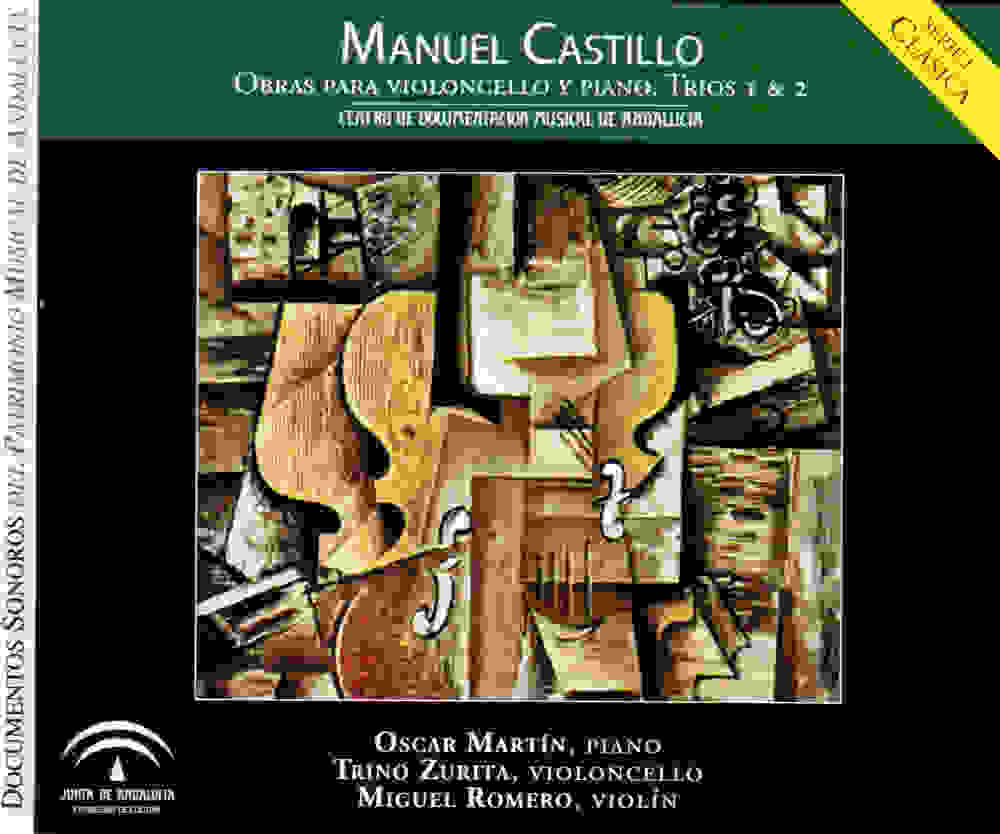Obras para Violoncello y Piano. TrÃos 1 & 2
Detail DS-0154 You can buy this record here 11 € Obras para Violoncello y Piano. TrÃos 1 & 2 Manuel Castillo
MANUEL CASTILLO
Obras para violoncello y piano
Trios 1 & 2
Sonata para violoncello y piano (1974)
1. I 6:50
2. II 5:30
3. III 2:58
Trio nº 1 (1983)
4. Moderato, sempre rubato 5:42
5. Scherzando 2:16
6. Lento espressivo 4:17
7. Allegretto deciso 2:09
Trio nº 2 (1987)
8. I 4:24
9. II 7:41
10. III 1:53
11. Alborada (1994) 8:35
12. Ricercare a Pau Casals (1976) 8:06
Oscar Martín, piano
Trino Zurita, violoncello
Miguel Romero, violín
|
About Manuel castillo Navarro-Aguilera was born in Sevilla in 1930. He displayed musical talent at an early age both as a pianist and as a composer. He studied in Sevilla with Norberto Almandoz (Chapel Master at the Cathedral) and in Madrid with A. Lucas Moreno (piano) and Conrado del Campo (composition). He was awarded the Joaquin Turina Prize when he was only 19, and at 21 he debuted as a pianist with the Bética Chamber Orchestra. He continued his studies in Paris with Lazare Levy (piano) and Nadia Boulanger (composition) and, after his return to Spain, he got a professorship at the Seville Conservatory in piano at the age of 26. That same year,(1956) he entered the seminary and was ordained in 1963 (although he left the priesthood later). In 1960 he won the (Spanish) National Prize for Music for his piano work Preludio, diferencias y tocata. Years later, in 1990, he would be awarded this same prize in recognition for his entire compositional output. From 1964-1978 he was director of the Seville Conservatory and was a decisive driving force behind it during those years. After resigning his post as director, he devoted his time to teaching composition (from 1972 on) and writng music. Throughout his life, he received numerous awards and public recognition for his work--perhaps best exemplified in 1992 by the fact that the Music College in Seville was named after him [Conservatorio Superior de Música Manuel Castillo]. He passed away in 2005. Manuel Castillo made a catalog of his own compositions, which include 139 works, starting with Tiempo de danza for piano in 1949 and ending with the Concierto Sacro Hispalense for organ solo, brass ensemble and kettledrums (premiered in 1997 at the Cathedral in Seville with J.E.Ayarra at the organ, plus soloists from the Seville Royal Symphony Orchestra, Juan Luis Pérez conducting. During his long career Castillo wrote in practically every musical form (except for the stage), but he was particularly fond of works that included his favorite instruments: the piano and the organ. The Sonata for cello and piano (1974) is the first work where the cello takes on an important role. It is dedicated to Castillo’s friend, the great Spanish cellist, Pedro Corostola and was premieredby him along with the pianist Luis Rego in Barcelona’s Palau de la Música on 14 November 1974. On the 28th, it was premiered in Seville. This is, without a doubt, one of the composer’s best and most successful works (comparable to his 1972 Piano Sonata). Although the composer openly admitted to using serial techniques in this piece, it might be better to say he employed free atonality (since serialism implies a strict use of material which is not found here). From a formal point of view, Castillo follows (in a Bartók-like manner) the structural semblance of a classical sonata: this solid framework lets him compose in larger forms, while by-passing the limits imposed by twelve-tone techniques and the basic principle of non-repetition. It is written in three movements which are meant to be performed with no break between each movement: he also does away with the traditional tempo indications and simply indicates metronome markings. The first movement begins with a short introduction in which the thematic and harmonic material are presented in a very concise fashion, leading into the the main part of the movement. This is the sonata-like “allegro”(mm 16th-note=200-208) with the usual contrasting themes and a three-part structure (exposition, development, recapitulation). This is rhythmically complicated; the exposition alternates a first “con brio” theme with a second “cantábile” expressionistic-like theme; after a relatively brief development, a symmetric recapitulation of the two main themes that, then, lead into the second movement. The second movement is a lyrical “adagio” (although the word itself does not appear). There is no time signature; by doing this Castillo invites the performer to actively take part in the recreation of the score. The opening theme is strictly serial and highly expressive. It appears in the solo cello (the real star of the show), to which the piano plays simple chords in a strictly accompanying role. After a middle section where both instruments begin a kind of diologue, the cello returns to a prominent role and repeats a slightly varied version of the opening melody. Then, the music dies away, creating a mysterious atmosphere (a descending glissando in the cello), and the third movement bursts in: a kind of “presto con fuoco”, with an almost diabolical character, exceptionally difficult for the performer. Written in A-B-A form, not even the middle section, which is somewhat more calm, can dispel the anguishing feeling of “moto perpetuo” that runs through the whole movement. Far from relaxing a bit toward the end, the exasperating coda only continues to intensify this feeling even more, bringing to a close one of Castillo’s most original and successful pieces. Juan Luis Pérez
|

